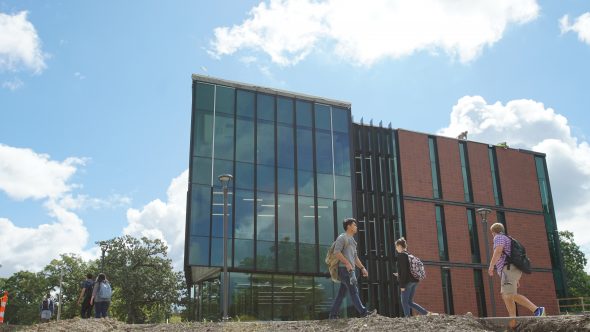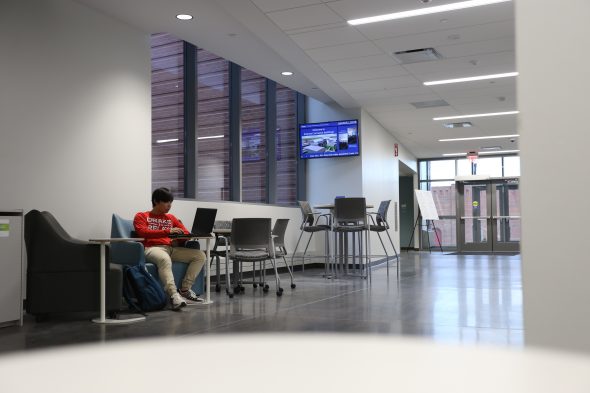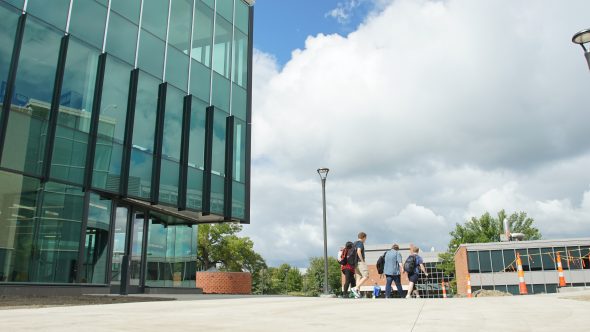
As the fall semester picks up steam at Drake University, students are effusive in their praise of Drake’s two new academic buildings. Collier-Scripps Hall and the Science Connector Building opened this fall as the centerpiece of Drake’s $52 million STEM@DRAKE initiative; students enjoy the buildings’ modern look and feel, collaborative work spaces, and updated technology.
“So far, I’ve heard lots of good comments,” said Andre Do, a third-year pharmacy student who works part-time as a front desk worker in Collier-Scripps, which is home to Drake’s School of Education, the Robert D. and Billie Ray Center, and the Department of Mathematics and Computer Science. “People love that the whole front of the building is glass—they say it has a strong aesthetic appeal. And they like that it brings many of the academic departments closer together.”

Noah Skantz, a senior studying neuroscience and biochemistry, cell, and molecular biology, has found his favorite location in the Science Connector Building. The second and third floors of the Science Connector Building are designed on a hub-and-spoke model, with a variety of classrooms and research labs all connecting to a central ‘hub’ with a wide variety of industry-standard equipment that students will encounter at many of Iowa’s largest and most innovative STEM workplaces. Skantz loves the hub on the second floor, where students and faculty from multiple scientific disciplines—from pharmacy, to molecular biology, to neuroscience—purposefully share equipment and ideas to tackle complex problems.
“The [layout] reflects the direction that higher education is headed,” Skantz said. “There is an increased emphasis on teamwork and interdisciplinary collaboration, which is a realistic reflection of how a professional workspace actually functions. In reality, there are not rigid scientific departments that separate career fields, but rather, any subject of study or research must call on several different fields in order to form a holistic view and reach novel solutions.”
Classrooms in Collier-Scripps were designed with the same emphases on classroom flexibility and educational technology. One classroom features eight digital screens and multiple video projectors; another has walls that double as whiteboards, so students can immerse themselves in complex mathematical formulas.

Hannah Puderbaugh, a Des Moines-area substitute teacher and a student in Drake’s Master of Science in Teaching program, recently relaxed in one of many private study spaces that can be found in the new academic buildings. Each “zip” space has re-arrangeable furniture and a large digital screen on which students can display their work.
“It’s really fancy,” Puderbaugh said of a zip space in Collier-Scripps. “I love the technology, the easy access to electrical outlets, and the glass walls and doors on either side of the room—because I like to see what’s going on around me, even while I study.”
The buildings also foster a feeling of campus unity. Faculty members in the sciences, math, and education who rarely saw one another prior to this week are finding that they now share a building or even a hallway. They’ve already begun to share ideas and experiment with technology that will enhance the classroom experience, said Assistant Professor of Teacher Education and Graduate Studies Jesse Wilcox, who specializes in training science teachers.
“Our job is to prepare our students to be effective and efficient teachers, and the new facilities allow us to model a variety of contemporary practices,” Wilcox said. “It’s only been a few days, but the faculty in the School of Education have already been talking to our new neighbors in the math department about incorporating virtual reality and 3D printing into our classrooms. That’s just an example of how we’re using our collaborative spaces, and our location in the heart of campus, to teach in a way that is current and innovative.”

Christopher Worland, a second-year student in the Master of Science in Counseling program, previously had all of his classes in the former School of Education building at 3206 University Ave. He took the opportunity to explore campus prior to his first class of the semester in Collier-Scripps Hall—he said he planned to do more of that in the future.
“If people would take more time to get out of their bubble, so to speak, and look around a little bit more, they’d be amazed at what they see,” said Worland.
He’d toured Meredith Hall and picked up a copy of the Drake Political Review, a student-produced publication that explores issues of deep social and political significance.
“I wasn’t expecting that high quality of journalism,” Worland said. “To me, that [writing] could have come out of The New York Times or some other very prestigious publication, so I was surprised.”
On a recent evening, Drake senior Chamindi Wijesinghe was wandering the halls of Collier-Scripps in search of a new go-to study spot. The actuarial science and information systems double-major was leaning toward a location on the second floor with plush chairs, moveable tables, and a wide view of Oreon E. Scott Chapel to the south and the science buildings, including Science Connector, to the north.
Collier-Scripps and the Science Connector Building are new to everyone on campus, but Wijesinghe expects the facilities will be particularly attractive to the next generation of Bulldogs.
“If I came in as a freshman and was given a campus tour,” she said, “Drake would definitely be someplace that I’d want to go.”


